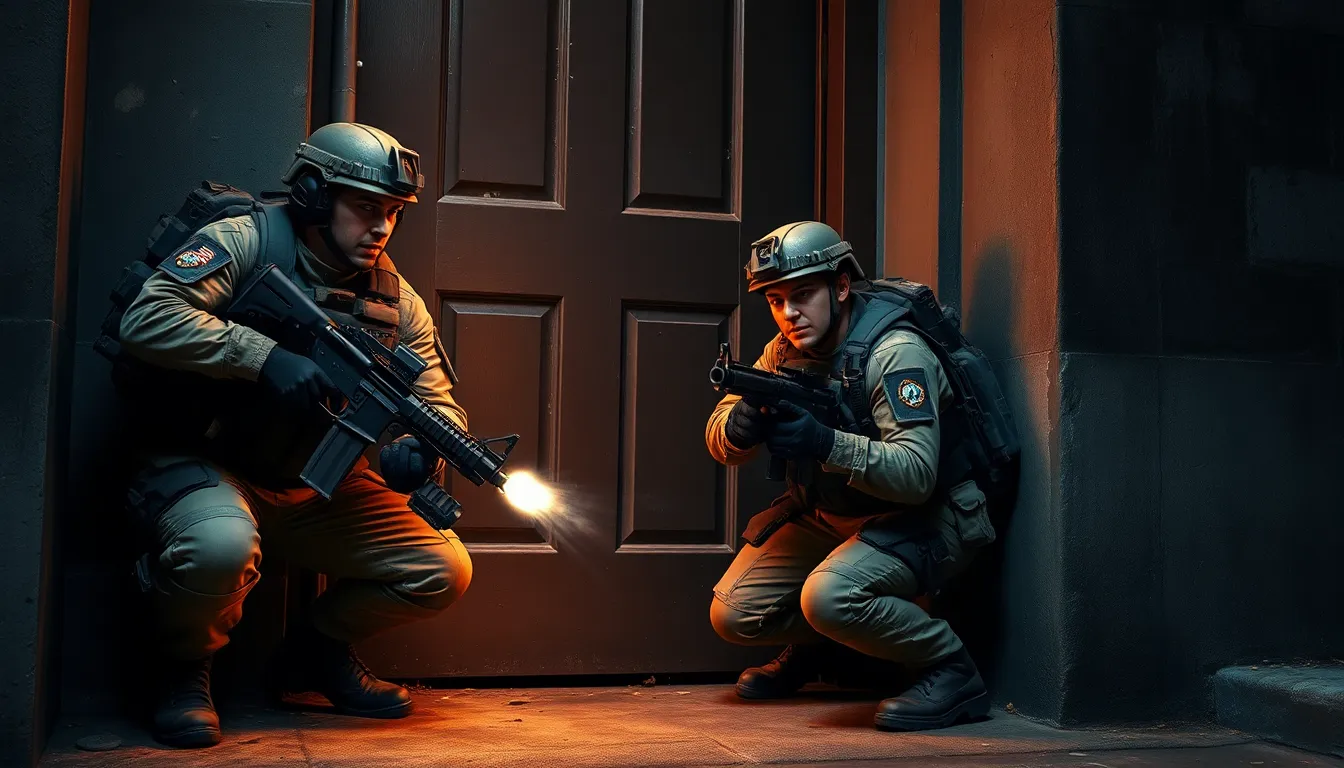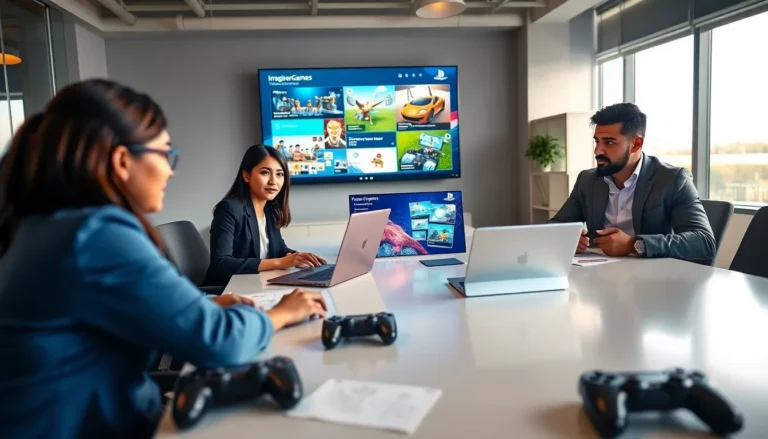Table of Contents
ToggleIn the fast-paced world of first-person shooters, breaching tactics can be the difference between victory and a spectacular faceplant. Imagine storming a room, adrenaline pumping, and executing a flawless entry that leaves your opponents scratching their heads. It’s not just about brute force; it’s about finesse, strategy, and maybe a sprinkle of luck.
Overview of FPS Breaching Tactics
Breaching tactics in first-person shooter games involve several strategies that increase the chances of successful room entries. Players use techniques such as flashbangs, smoke grenades, or tactical maneuvers to disorient opponents. Combining these elements allows teams to gain significant advantages in high-pressure scenarios.
Employing stealth tactics can also prove valuable. Players who approach silently often catch enemies off-guard. Awareness of sound cues adds another layer of strategy, making careful movement essential.
Entry formations play a crucial role in breaching. Maintaining spacing between teammates prevents multiple players from becoming targets at once. By checking angles and using cover effectively, players minimize vulnerability during entry.
Communication within teams enhances effectiveness. Clear calls and concise directives ensure every member understands their role. Failing to communicate can lead to disjointed tactics, ultimately jeopardizing a team’s success.
Using the environment strategically contributes to effective breaching outcomes. Players who utilize walls, furniture, or obstacles can create cover while advancing. Knowing where to find advantageous positions can shift the tides of battle.
Practice and familiarity with maps also improve breaching skills. Players who learn layout nuances develop intuition for effective tactics. Repeated practice can build muscle memory and confidence in executing complex maneuvers.
Focusing on tactical knowledge helps players adapt to various scenarios. Flexibility in approach allows teams to counter unexpected challenges effectively. Overall, mastering these breaching tactics forms a foundational skill set for dominating gameplay in competitive settings.
Types of Breaching Techniques

Breach tactics in FPS games can be categorized into two primary approaches: dynamic and deliberate breaching, each serving a unique purpose in gameplay.
Dynamic Breaching
Dynamic breaching focuses on swift, aggressive entries. Players often use speed and mobility to overwhelm opponents. Commonly, this involves utilizing grenades or breaching charges to create quick openings. Using flashbangs disorients defenders while teammates rush in to secure the space. Players coordinate timing to enhance effectiveness. This tactic thrives in fast-paced scenarios where opponents lack situational awareness. Quick adaptability is essential here, as plans must adjust based on enemy responses. Teams that practice dynamic breaching consistently improve their reaction times and overall effectiveness in combat.
Deliberate Breaching
Deliberate breaching emphasizes thorough planning and coordination. Teams carefully prepare for engagements by assessing enemy positions and potential threats. This approach often includes methodical movements into a room or area. Players deploy reconnaissance tools, such as drones or cameras, to gather intelligence. Timing and communication hold significant importance, ensuring all members are aligned in their actions. Often, players utilize diversion tactics to draw fire, allowing others to move in safely. Mastery of deliberate breaching enhances a team’s ability to control engagements and build tactical advantages during critical moments.
Tools and Equipment Used
Effective breaching tactics require a combination of specialized tools and protective gear. The right equipment enhances readiness and team effectiveness.
Breaching Tools
Key breaching tools include flashbangs, smoke grenades, and breaching charges. Flashbangs disorient opponents, creating openings for entry. Smoke grenades obscure visibility, offering cover during movement. Breaching charges enable fast access to barricaded doors or walls. Other tools like tactical entry tools and shotguns assist in forcing entry without extensive damage. Advanced gadgets, such as drones, provide reconnaissance, helping teams gather vital information before engaging. Teams often prioritize these tools based on mission requirements, ensuring a balanced approach in dynamic or deliberate breaching scenarios.
Protective Gear
Protection remains crucial during breaching operations. Tactical vests safeguard against bullets, while helmets protect against head injuries. Body armor distributes impact, enhancing player survivability in intense situations. Ear protection muffles blasts and reduces disorientation from explosions. Additionally, gloves enhance grip and dexterity when handling tools. First responders add emergency medical kits for immediate care if injuries occur. Ensuring all team members wear suitable gear boosts overall operational effectiveness and safety during high-risk entries.
Team Coordination and Communication
Team coordination and communication play vital roles in executing successful breaching tactics. Clear understanding among team members increases efficiency and minimizes risks during engagements.
Roles and Responsibilities
Each team member contributes specific skills that enhance overall effectiveness during breaching. The point person leads the charge, making instant decisions based on situational awareness. Support roles provide cover and assist with equipment, ensuring that necessary tools are ready and accessible. Communication specialists relay critical information regarding enemy positions and environmental hazards. Every player must be aware of their assigned tasks to prevent confusion, enabling synchronized actions that maximize tactical advantages.
Effective Communication Strategies
Utilizing concise communication fosters quick decision-making in fast-paced scenarios. Establishing predefined signals or codes simplifies complex messages during high-pressure moments. Frequent updates on enemy movements from reconnaissance enables adaptation as situations evolve. Regular briefings before missions allow teams to discuss strategies and reinforce coordination. Active listening ensures that all members remain informed and responsive, contributing to fluid gameplay. Together, these strategies enhance team synergy, leading to higher success rates in breaching operations.
Real-World Applications and Scenarios
Breach tactics find extensive use in military training exercises and law enforcement operations. Teams apply these methods to enter buildings and neutralize threats while minimizing risks. Tactical units often conduct drills that simulate various entry scenarios, honing their skills in dynamic and deliberate breaching.
Success in these operations hinges on teamwork and communication. Each participant understands their role, from the point person leading the entry to the team member providing cover. Practice allows teams to refine their strategies, ensuring fluidity during real-world situations.
Specialists employ a mix of equipment tailored to specific environments. Flashbangs and smoke grenades support entries into heavily fortified locations, allowing teams to disorient adversaries during critical moments. Reconnaissance drones gather pre-entrance intelligence, offering crucial insights into enemy positions and movements.
Safety remains paramount during these operations. Tactical gear like helmets and body armor safeguards personnel against potential threats. Ensuring that every team member is equipped with the appropriate tools enhances operational effectiveness and boosts confidence during engagements.
In law enforcement, breaching tactics prove vital in hostage situations. Officers carefully evaluate the scene, utilizing communication and intel to determine the best entry point. The success of these operations often relies on the ability to implement strategies that prioritize safety while achieving objectives.
In competitive gaming, players mimic these real-world tactics, adapting their skills for in-game success. Understanding room layouts and enemy patterns leads to more effective breaches. Mastery of both dynamic and deliberate approaches enhances their gameplay, allowing them to respond efficiently during intense match situations.
Breaching tactics play a pivotal role in first-person shooter games. Mastering these skills not only enhances gameplay but also fosters teamwork and communication among players. Whether employing dynamic or deliberate approaches, understanding the nuances of each technique can significantly improve a team’s effectiveness in high-pressure situations.
Utilizing specialized tools and maintaining situational awareness are essential for successful room entries. Players must adapt real-world strategies to their gaming experience, ensuring they’re prepared for any scenario. By honing these tactics, gamers can elevate their performance and dominate the competition.







